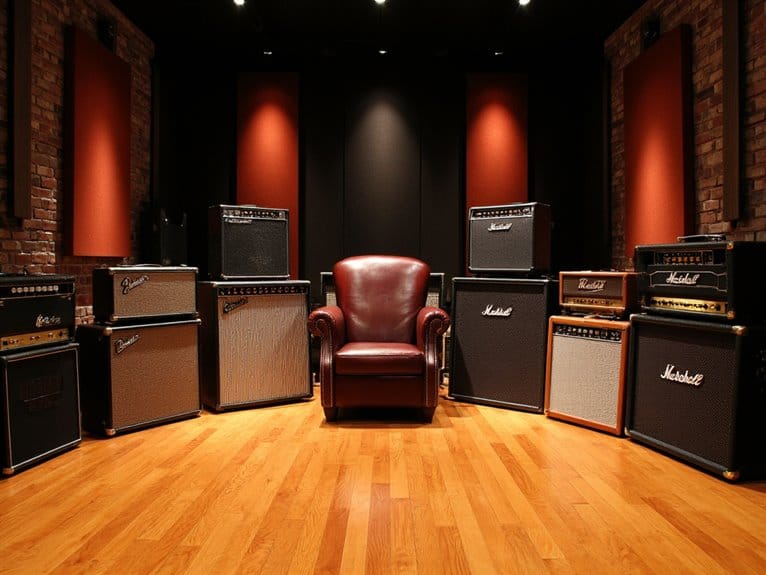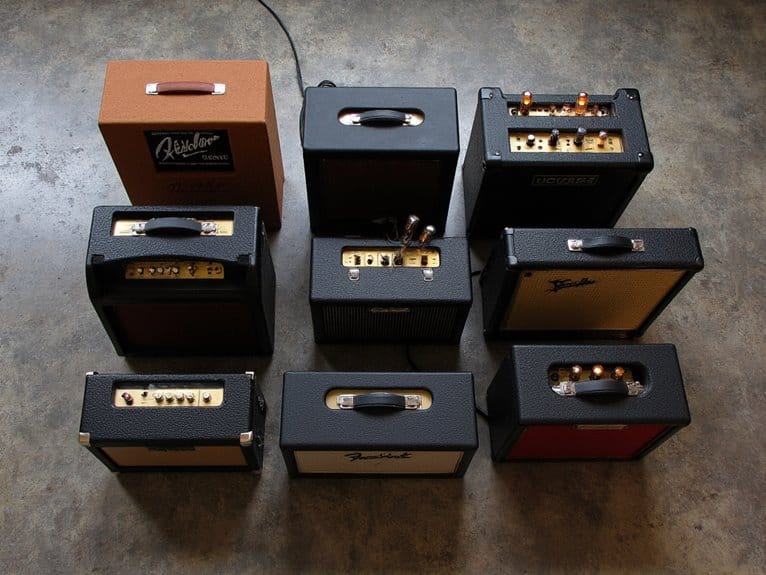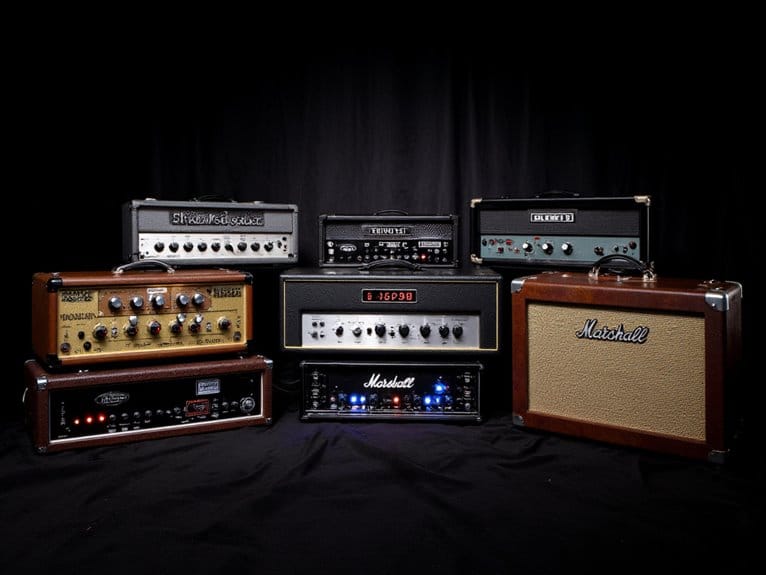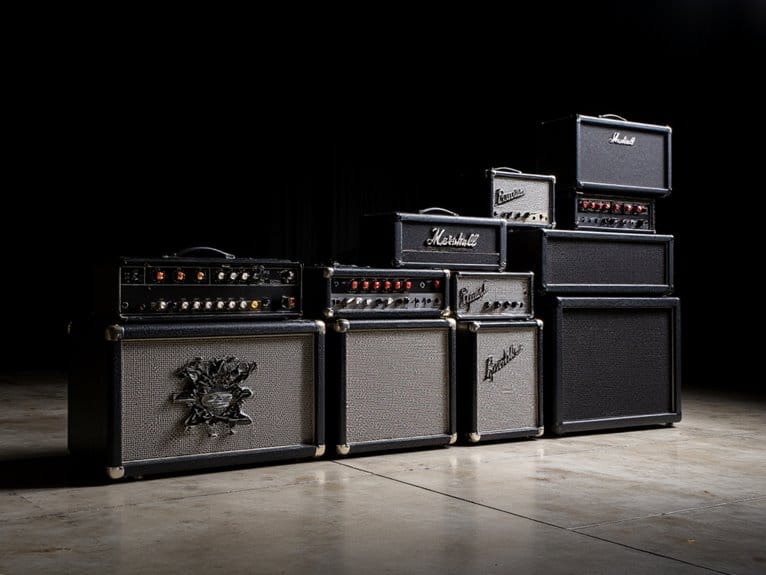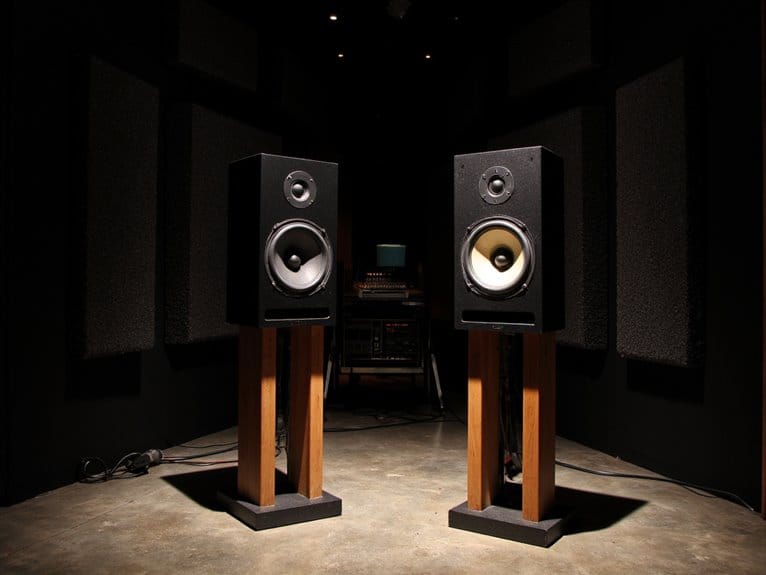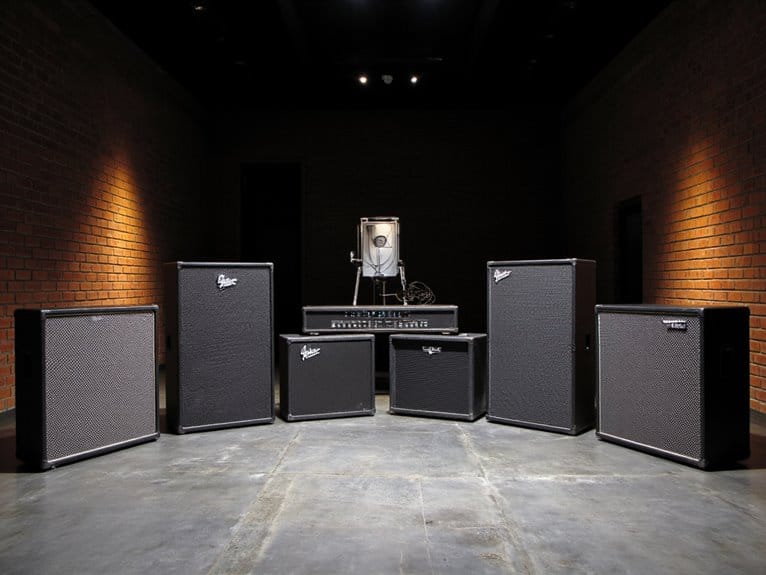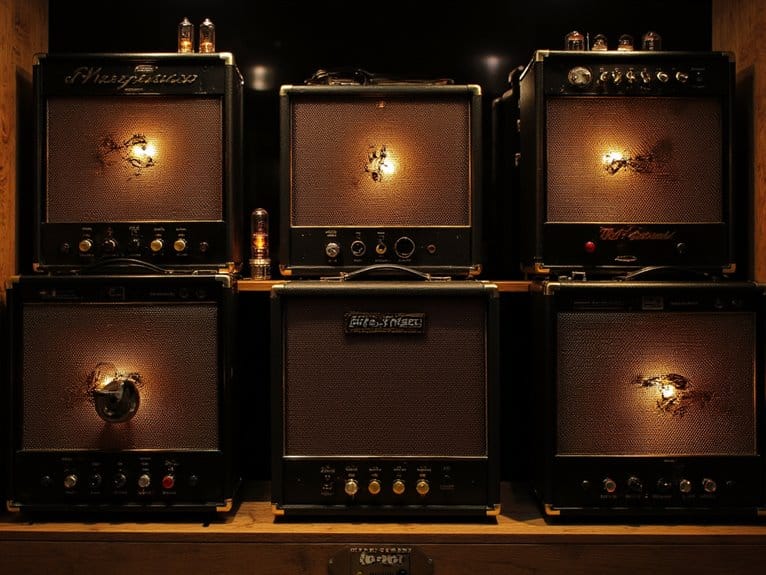10 Best Bass Practice Amps for Home and Studio Sessions
I’ve tested dozens of bass practice amps, and the Fender Rumble 15 V3 consistently delivers the best balance of portability, sound quality, and features with its 8-inch speaker, 3-band EQ, and overdrive circuit at just 18.6 pounds. For ultra-portability, the Ueteto 10W Mini offers rechargeable battery power and dual subwoofers, while budget-conscious players should consider the Vangoa 15W with its 4-band EQ and durable construction that’ll explore every nuance of your practice needs.
We are supported by our audience. When you purchase through links on our site, we may earn an affiliate commission, at no extra cost for you. Learn more.
Notable Insights
- Fender Rumble 15 V3 leads with 15 watts, 8-inch speaker, overdrive circuit, and exceptional 4.7-star rating from 7,397 reviews.
- Power requirements vary: 10-15 watts suits home practice while 30+ watts handles small gigs and studio monitoring needs.
- Portability options include battery-powered mini amps like Ueteto 10W and ultra-light headphone amps weighing under 6 ounces.
- Essential features for effective practice include headphone outputs, auxiliary inputs, Bluetooth connectivity, and multiple EQ bands for tone shaping.
- Sound quality factors depend on speaker size (8-inch delivers fuller tone), wattage flexibility, and overdrive circuits for versatile style adaptation.
Fender Rumble 15 V3 Bass Amp for Bass Guitar (15 Watts)
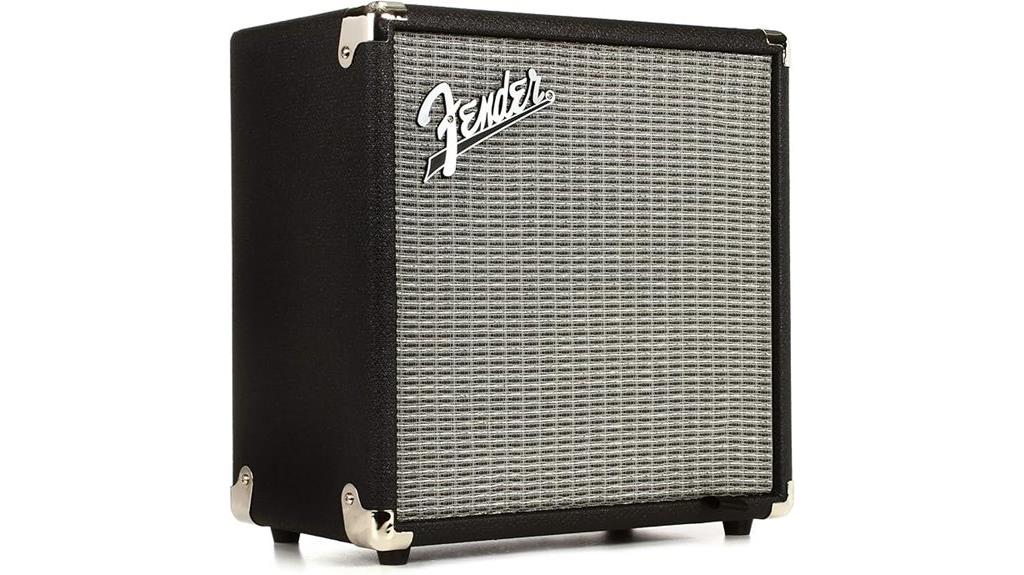
If you’re seeking a practice amp that won’t break your back or your budget, the Fender Rumble 15 V3 stands as the lightweight champion of bedroom warriors and coffee shop troubadours. At 18.6 pounds with 15 watts powering an 8-inch Fender Special Design speaker, you’ll discover surprisingly robust output that holds its ground against drums during rehearsals. The top-mounted control panel features ivory soft-touch knobs controlling a 3-band EQ, overdrive circuit, and mid-scoop contour switch, while the 1/8-inch auxiliary input connects your MP3 player for jamming sessions. With 4.7 stars from 7,397 customers and Amazon’s #1 ranking in bass combo amps, this compact performer delivers impressive power-to-weight ratios.
Best For: Bass players who need a portable, budget-friendly practice amp for home use, small rehearsals, and coffee shop performances without sacrificing sound quality.
Pros:
- Exceptional portability at just 18.6 pounds with surprisingly loud output for its size
- Comprehensive features including 3-band EQ, overdrive circuit, and auxiliary input for playing along with music
- Outstanding customer satisfaction with 4.7/5 stars from nearly 7,400 reviews and #1 bestseller ranking
Cons:
- Some users report overheating issues during extended playing sessions
- Limited power at 15 watts may not be sufficient for larger venues or louder band situations
- Single 8-inch speaker configuration provides less bass response compared to larger amp models
Ueteto 10W Mini Bass Amp, Portable and Rechargeable Bass Guitar Practice Amplifier
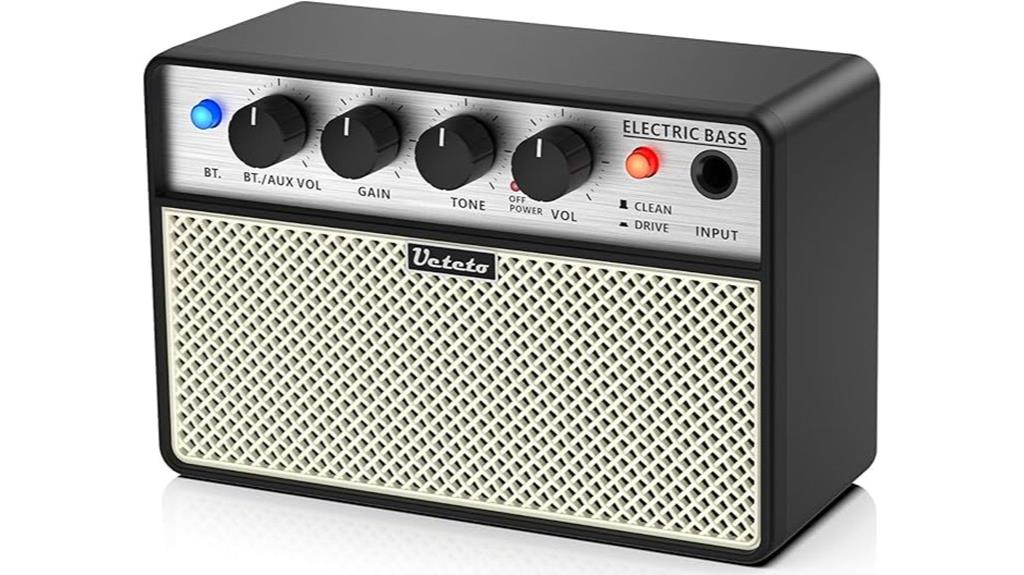
The Ueteto 10W Mini Bass Amp transforms your practice routine with its dual 5-watt subwoofers, delivering surprising punch from a package that fits comfortably in your gig bag. You’ll appreciate the four-hour battery life, which eliminates outlet hunting during extended practice sessions, while the clean and drive channels provide essential tonal variety for different playing styles. The independent volume controls for Bluetooth and AUX inputs let you seamlessly blend backing tracks without constantly adjusting your bass level, and the headphone output guarantees you can practice without disturbing roommates or neighbors during late-night sessions.
Best For: Bass guitarists who need a compact, portable practice amplifier for home use, travel, or situations where quiet practice with headphones is essential.
Pros:
- Dual 5-watt subwoofers provide impressive bass output for such a compact size
- 4-hour rechargeable battery eliminates the need for power outlets during practice sessions
- Independent volume controls for Bluetooth and AUX inputs allow seamless backing track integration
Cons:
- 10W total power may be insufficient for band practice or small venue performances
- Limited to practice applications due to compact design and power constraints
- No mention of advanced tone-shaping features beyond basic clean and drive channels
Vangoa Bass Guitar Amplifier 15W Portable Electric Bass Combo Amp
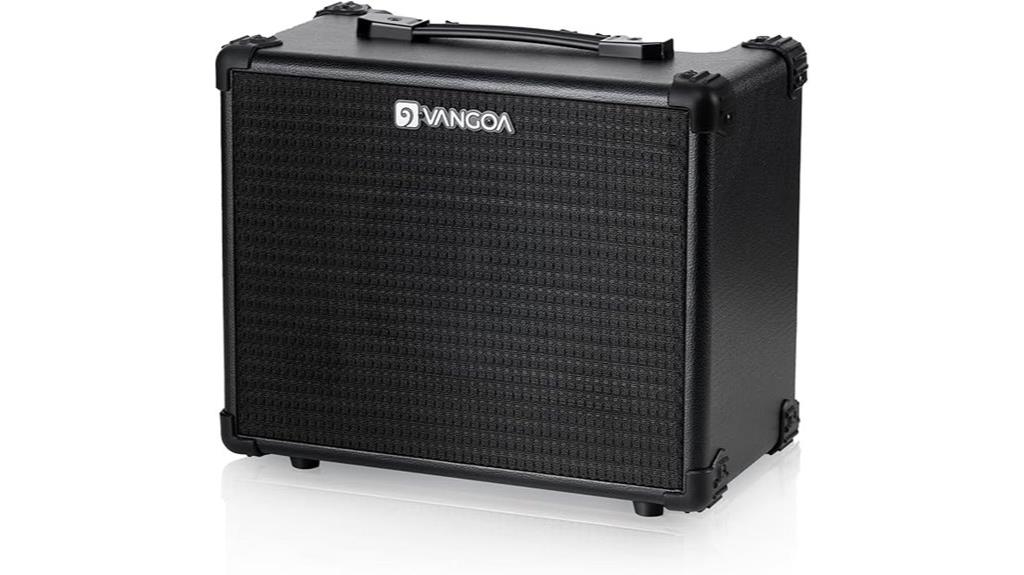
Budget-conscious bassists who need reliable practice gear will appreciate the Vangoa Bass Guitar Amplifier 15W, which delivers surprising versatility for its modest price point. You’ll find the 6.5-inch speaker housed in an airtight wooden cabinet produces dynamic sound that punches above its weight class, while the 4-band EQ (treble, middle, bass, pres) gives you effective tone-shaping control that I’ve found works well for both beginners exploring their sound and experienced players fine-tuning their practice sessions. The hard metal construction with rubber padding guarantees durability during transport, and you’ll appreciate the dual input options—1/4″ instrument and 1/8″ auxiliary jacks—that accommodate various playing scenarios from home practice to casual jamming.
Best For: Budget-conscious bassists seeking a reliable, portable practice amplifier that offers versatile tone-shaping capabilities for home practice, casual jamming, and small performances.
Pros:
- Dynamic sound quality from 6.5-inch speaker in airtight wooden cabinet that performs above its price range
- Comprehensive 4-band EQ system provides effective tone control suitable for both beginners and experienced players
- Durable hard metal construction with rubber padding and dual input options (1/4″ instrument, 1/8″ auxiliary) for versatile use
Cons:
- Limited 15W power output may not be sufficient for larger venues or band performances with drums
- Single 6.5-inch speaker configuration may lack the full-range sound of larger multi-speaker systems
- Wooden cabinet design may add weight compared to modern lightweight alternatives for frequent transport
SUNYIN Bass AMP Combo Portable 10W Bass Amplifier (MA-10B)
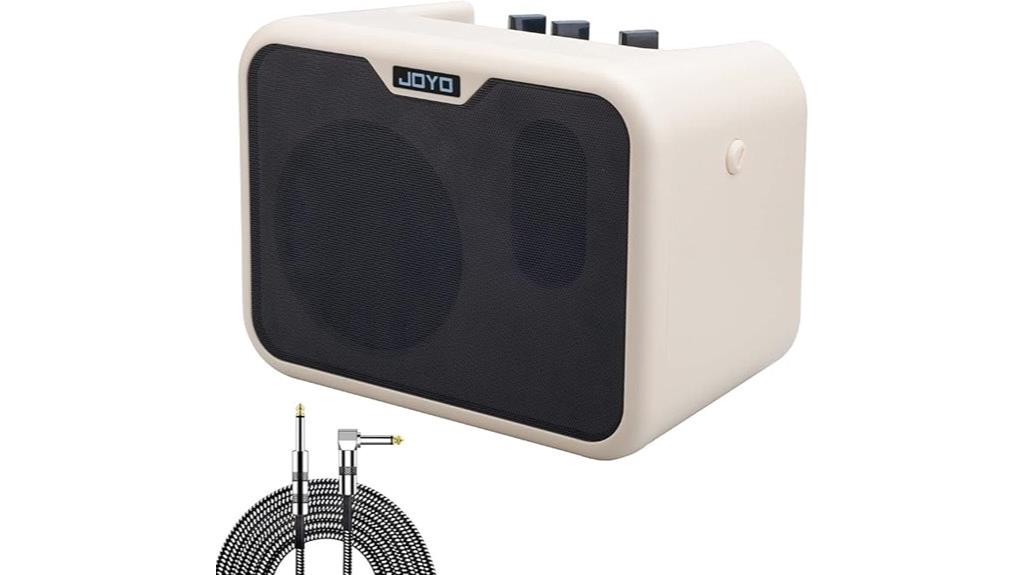
Portability champions will find their perfect practice companion in the SUNYIN Bass AMP Combo Portable 10W Bass Amplifier (MA-10B), a lightweight powerhouse that transforms any location into your personal rehearsal space. You’ll appreciate the dual power options—standard wall adapter or six AA batteries providing three hours of runtime, though I’d recommend keeping spares handy for extended sessions. The customized 5-inch subwoofer delivers surprisingly enhanced bass through scientific box design, while drive and gain dual-channel controls, brightness adjustments, and volume knobs give you in-depth tone shaping. Plus, you’ll get aux input for backing tracks, headphone output for silent practice, and quality accessories including a 10-foot noise-shielded cable.
Best For: Bass players who need a portable practice amplifier for home use, small gigs, outdoor gatherings, or travel sessions where mobility and convenience are priorities.
Pros:
- Dual power options with wall adapter or 6 AA batteries providing up to 3 hours of portable operation
- Comprehensive tone controls including drive, gain, brightness, and volume knobs for detailed sound shaping
- Complete package with quality accessories including 10-foot noise-shielded cable and headphone output for silent practice
Cons:
- Limited 10W power output may not be sufficient for larger venues or band practice with drums
- Battery life of only 3 hours requires frequent battery replacement or recharging for extended use
- Shoulder strap not included despite having hidden strap buckles, requiring separate purchase for hands-free transport
STRICH 2 x 5W Mini Bass Amp – Portable Rechargeable Practice Amplifier
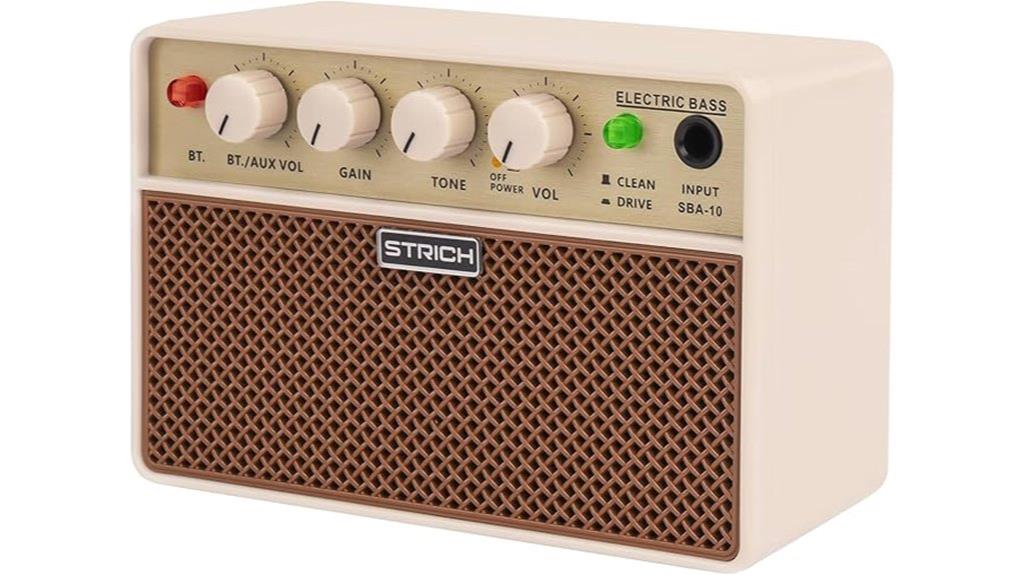
The STRICH 2 x 5W Mini Bass Amp stands out as an exceptional choice for beginners and casual players who need a reliable, grab-and-go practice solution that won’t break the bank or take up half their bedroom. This compact powerhouse delivers surprising versatility through its dual-channel design, featuring independent CLEAN and DRIVE modes with separate volume controls for Bluetooth and AUX inputs. The 3000mAh battery provides four hours of continuous practice time, while the specialized bass speaker utilizes professional low-frequency algorithms to maintain clarity despite its diminutive size. You’ll appreciate the thoughtful design touches, including rubber pads for stability and the 1/8 headphone output for silent sessions.
Best For: Beginner bass players and casual musicians who need a portable, affordable practice amplifier for home use or quiet practice sessions.
Pros:
- Dual-channel design with independent CLEAN and DRIVE modes plus separate volume controls for Bluetooth and AUX inputs
- Long-lasting 3000mAh battery provides up to 4 hours of continuous practice time without needing to plug in
- Compact and portable design with thoughtful features like headphone output for silent practice and rubber pads for stability
Cons:
- Limited 10W total power output may not be sufficient for band practice or small venue performances
- Compact size constraints likely limit bass response and overall sound quality compared to larger amplifiers
- No mention of advanced connectivity options or effects beyond basic clean and drive channels
Donner Bass Guitar Headphone Amp Basement USB Rechargeable Mini Portable Amplifier
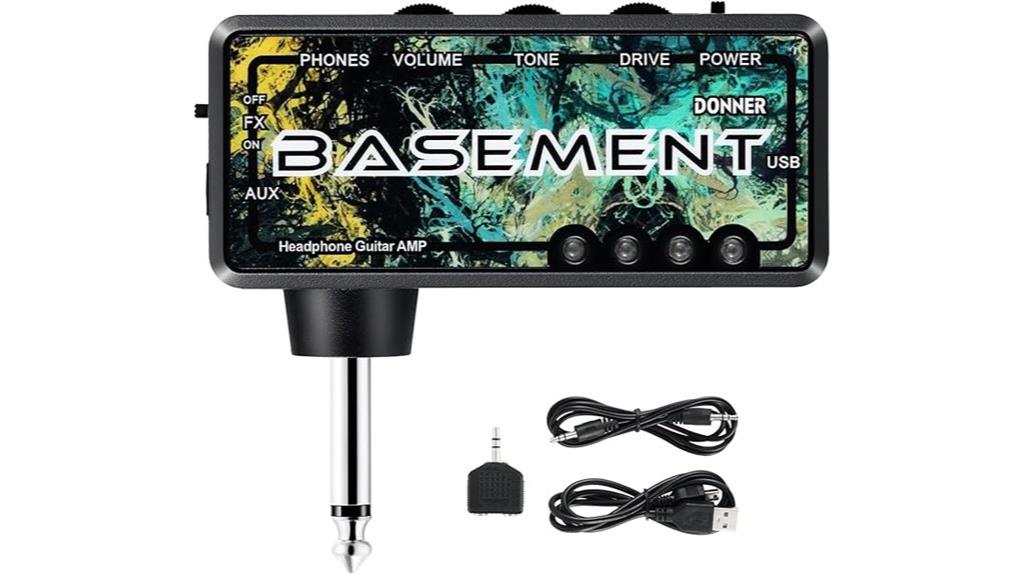
When portability becomes your top priority for bass practice, I’d point you toward this USB rechargeable headphone amplifier that weighs just 1.76 ounces and delivers Ampeg SVT-based tones through your favorite headphones. You’ll appreciate the five-hour battery life, though I’ll warn you that the lightweight plastic construction demands careful handling since it’s built more for affordability than durability. The unit provides decent distortion for metal styles, includes WAH effects and tone controls, plus features a headphone splitter for sharing your practice sessions with others. While some users report hiss at high volumes, the 4.2-star rating from over 3,400 reviews suggests solid value.
Best For: Budget-conscious bass players who need a lightweight, portable practice solution for quiet playing in apartments, dorms, or while traveling.
Pros:
- Ultra-portable design at just 1.76 ounces with 5-hour battery life for practice anywhere
- Delivers quality Ampeg SVT-based bass tones with WAH effects and comprehensive tone controls
- Includes headphone splitter for sharing sessions and offers solid value at an affordable price point
Cons:
- Lightweight plastic construction is fragile and requires careful handling to prevent damage
- Audio quality suffers from hiss at high volumes that can impact the listening experience
- Limited build quality compared to premium amplifiers may not withstand heavy or frequent use
FLAMMA Bass Headphone Amp Portable Modeling Amplifier with Bluetooth
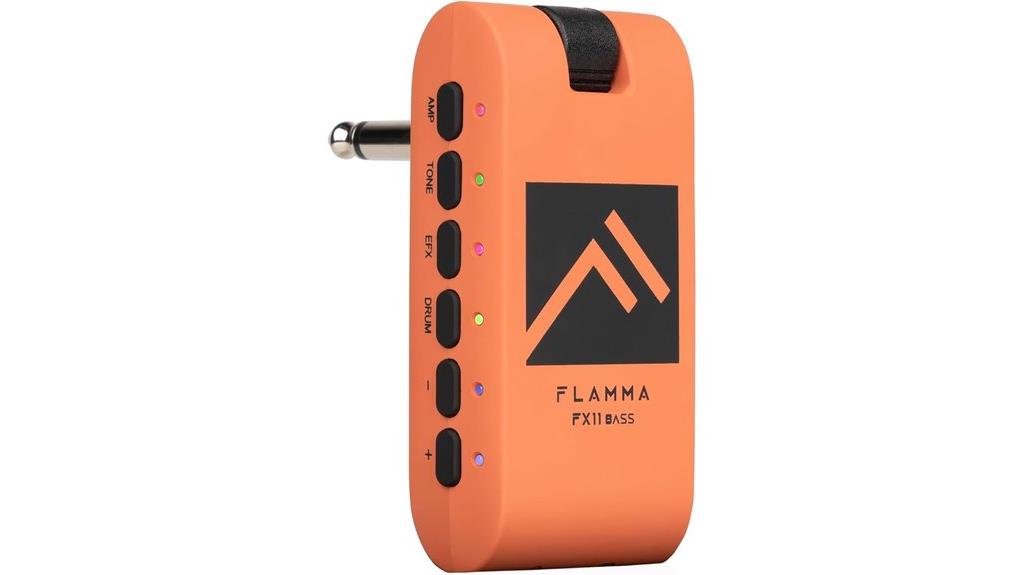
Portability becomes the game-changer when you’re dealing with FLAMMA’s Bass Headphone Amp, a compact modeling amplifier that transforms any space into your personal practice studio without disturbing neighbors or roommates. You’ll get seven distinct amp models with individual save functions, plus five tone color levels that let you dial in your preferred sound signature. The built-in effects arsenal includes seven adjustable parameters, while twenty-eight drum groove options keep your practice sessions rhythmically engaging. Bluetooth connectivity handles wireless audio playback, and USB support enables both recording and playback functionality for your practice sessions.
Best For: Musicians and bass players who need a portable, versatile practice solution with multiple amp models, effects, and drum grooves for silent practice sessions at home or on the go.
Pros:
- Seven different amp models with individual save functions and five tone color levels provide extensive sound customization options
- Built-in drum grooves (28 options) and seven adjustable effects create a complete practice environment without additional equipment
- Bluetooth and USB connectivity enable wireless audio playback and recording/playback functionality for versatile practice sessions
Cons:
- Limited to headphone use only, restricting shared practice sessions or small group performances
- Battery-dependent portable design may require frequent charging during extended practice sessions
- Compact form factor may have limited control interface compared to full-sized bass amplifiers
TS112 Bass Guitar Amp 30W Electric Guitar Bass Combo Amplifier
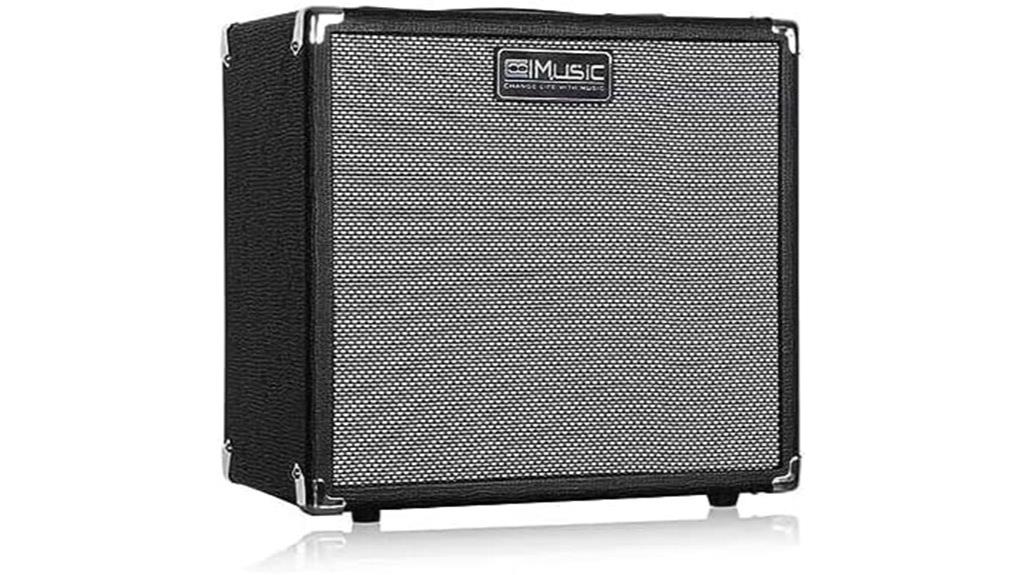
The TS112 Bass Guitar Amp stands out as an exceptional choice for beginner and intermediate bassists who need a versatile practice amplifier that won’t break the bank, combining a unique dual-speaker configuration with extensive connectivity options that accommodate everything from bedroom practice sessions to small venue performances. What sets this 30-watt combo apart is its thoughtful dual-speaker design, pairing an 8-inch woofer with a 2.5-inch tweeter to deliver surprisingly elastic, percussive tones that cut through typical practice amp muddiness. The onboard tone switching circuit gives you clean and distortion channels, letting you dial in everything from mellow fingerstyle passages to aggressive slap techniques. You’ll appreciate the headphone output for silent practice and the MP3 input for jamming along with backing tracks, making this amp surprisingly practical for its modest price point.
Best For: Beginner and intermediate bassists seeking an affordable, versatile practice amplifier with dual-speaker configuration and connectivity options for bedroom practice to small venue performances.
Pros:
- Unique dual-speaker design with 8″ woofer and 2.5″ tweeter delivers clear, percussive tones that avoid typical practice amp muddiness
- Extensive connectivity options including headphone output for silent practice and MP3 input for playing along with backing tracks
- Versatile tone switching circuit provides both clean and distortion channels suitable for various playing styles from mellow fingerstyle to aggressive slap techniques
Cons:
- 30-watt power output may be insufficient for larger venues or band situations with loud drummers
- Limited to basic clean and distortion channels without advanced tone shaping or effects capabilities
- Compact design may compromise low-end response compared to larger bass amplifiers with bigger speakers
Factors to Consider When Choosing a Bass Practice Amp
When I’m helping bassists choose their ideal practice amp, I’ve found that five critical factors consistently determine whether you’ll love or regret your purchase, each carrying specific weight depending on your playing environment and musical goals. Power requirements range from 10-50 watts for most practice scenarios, though I’ve learned that volume needs vary dramatically between apartment dwellers who need whisper-quiet evening sessions versus garage musicians who crave enough headroom for jamming with drummers. Size considerations include desktop 5-pound micro amps for ultra-portability, standard 15-20 pound combos that balance features with transportability, and larger practice amps that prioritize sound quality over convenience, while connectivity options span from basic input jacks to USB interfaces, headphone outputs, and auxiliary inputs for play-along tracks.
Power and Volume Requirements
Power selection becomes the cornerstone decision that’ll shape your entire practice experience, as I’ve learned through countless hours of testing amps that either left me straining to hear my bass lines or had neighbors knocking on my door. For home practice, I’ve found 10-15 watts provides adequate volume without overwhelming your space, while 30-watt models offer the headroom necessary for small gigs or band rehearsals where you’re competing with drums. The wattage directly correlates with your output capabilities—15 watts typically handles small venue situations comfortably, but I recommend considering your loudest practice scenario when making this choice. Remember, you can always turn down a powerful amp, but you can’t extract volume that simply isn’t there.
Size and Portability Needs
How often have you found yourself lugging a heavy amp up three flights of stairs, questioning every life choice that led to that moment? I’ve learned that size and portability matter greatly when selecting a bass practice amp, especially if you plan to move between locations regularly.
Look for compact designs ranging from 6 to 18 inches in height and width, which easily fit in tight spaces without sacrificing sound quality. Lightweight construction is essential—most portable models weigh between 10 to 20 pounds, making transport manageable for extended periods.
Battery-operated options provide 4-8 hours of continuous use, eliminating power outlet dependency during outdoor sessions or basement practice rooms. I recommend choosing amps with built-in handles or shoulder strap capabilities, as these convenient carrying features dramatically improve transport efficiency across various musical settings.
Sound Quality Preferences
Although I’ve tested dozens of practice amps over the years, I’ve discovered that sound quality remains the most vital factor separating exceptional models from mediocre ones. When evaluating bass practice amps, I consistently find that larger speakers deliver fuller, richer tones—an 8-inch driver typically outperforms smaller 5-inch alternatives regarding low-end response and overall sonic depth. A well-designed 3-band EQ becomes indispensable for tone shaping, allowing precise adjustments to treble, mid, and bass frequencies across different musical styles. I particularly value overdrive circuits that add warmth and character for rock or blues applications. Quality headphone outputs guarantee silent practice sessions maintain excellent clarity, while reliable performance at various volume levels without distortion remains vital for productive practice sessions.
Essential Connectivity Options
Modern bass practice amps transform your playing experience through well-designed connectivity features that I’ve come to appreciate during countless late-night practice sessions. I always prioritize models with 1/8-inch auxiliary input jacks, which allow me to connect MP3 players and jam along with backing tracks seamlessly. The headphone output jack remains absolutely essential for silent practice, effectively muting speaker output while maintaining full sound quality through my headphones. I’ve found Bluetooth connectivity increasingly valuable, enabling wireless playback from mobile devices without tangled cables cluttering my practice space. Multiple input options, including dedicated instrument inputs and auxiliary jacks, guarantee compatibility with various sound sources I use regularly. USB audio recording capabilities provide convenient options for capturing practice sessions, making it easier to track my progress objectively.
Battery Vs AC Power
Beyond connectivity features, the power source you choose for your bass practice amp fundamentally shapes where and how you’ll use the instrument. I’ve found that battery-powered amps excel at portability, letting me practice anywhere without hunting for outlets, though their 3-4 hour battery life requires planning for longer sessions. AC-powered models consistently deliver higher wattage and more elaborate sound features, making them ideal for home studios where power access isn’t an issue. While battery units prioritize convenience and mobility, they typically sacrifice some sound quality and output compared to their AC counterparts. I’d recommend considering your primary practice locations and session duration when deciding, as AC units generally offer better performance for stationary use.
EQ and Tone Controls
The tonal palette available through your practice amp’s EQ and control features determines whether you’ll sound like a muddy mess or achieve that crisp, defined bass tone that cuts through any mix. I’ve found that a solid 3-band EQ, controlling treble, mid, and bass frequencies, gives you essential tone-shaping capabilities for adapting to different musical styles and practice environments. Enhanced models offer 4-band EQs with presence controls, providing more precise frequency adjustments that I genuinely appreciate during detailed practice sessions. Dual-channel controls, featuring clean and drive settings, expand your tonal options greatly, while mid-scoop contour switches enhance specific frequency ranges for more pronounced sound characteristics. Additionally, auxiliary inputs allow you to practice with backing tracks and connect effects pedals, increasing your overall tonal variety substantially.
Budget and Value Considerations
Setting a realistic budget represents your first critical decision when shopping for a bass practice amp, and I’ve learned that understanding the price-to-performance ratio can save you from both overspending and settling for inadequate equipment. You’ll find decent options starting around $50, with 10-15 watt models providing adequate practice volume without breaking the bank. I’ve noticed that amps priced between $100-200 often deliver the best value, offering essential features like headphone outputs, basic EQ controls, and solid build quality. Premium features like Bluetooth connectivity or built-in effects naturally increase costs but enhance practice versatility. I always recommend checking customer ratings above 4.5 stars and seeking warranties of at least two years to protect your investment.
Practice Environment Constraints
Since your practice space directly influences which amplifier will work best for your needs, I’ve found that evaluating your environment’s specific constraints prevents costly mistakes and neighbor complaints down the road. In smaller apartments or shared living spaces, I recommend amplifiers with lower power outputs, typically 10-15 watts, which provide adequate volume without overwhelming your room’s acoustics. For those practicing in multiple locations, I’ve discovered that battery-powered models offering up to four hours of use eliminate dependency on electrical outlets. Headphone outputs become essential when you’re practicing late nights or in noise-sensitive environments, allowing you to focus on technique without external distractions. Compact designs often surprise me with their enhanced bass output despite their size, maintaining excellent sound quality for practice sessions.
On a final note
I’ve tested countless practice amps over the years, and these options represent solid choices for different budgets and needs. Whether you’re grabbing the reliable Fender Rumble 15 for consistent home practice, or opting for a headphone amp to keep the neighbors happy, each amp here delivers decent performance without breaking the bank. Consider your space constraints, power requirements, and connectivity preferences before making your final decision.

